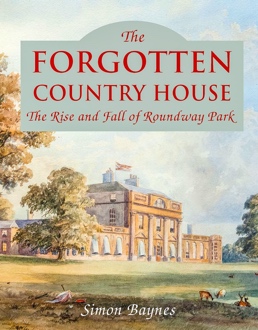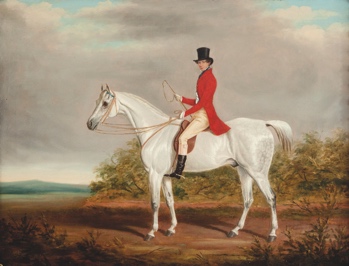The Forgotten Country House
Posted: 2019-10-25
The late 18th century was the golden age of the English country house. Inspired by fashionable Palladian architects like Robert Adam and landscape gardeners such as Lancelot 'Capability' Brown, the landed gentry of England created mansions like works of art, set in idyllic countryside settings.
Though many of these stately homes remain and are some of England's best-loved historic buildings, others have been lost to the ravages of time, as changes in society made the lifestyle of the landed gentry difficult to maintain.
One of these lost country houses was Roundway Park near Devizes in Wiltshire.
In 'The Forgotten Country House: The Rise and Fall of Roundway Park' author Simon Baynes traces the history of Roundway Park from its inception in 1777 to its partial demolition in 1954. Baynes is descended from the Colston family who owned Roundway Park (or New Park as it was known then) in 1840. The story of how Baynes became fascinated by Roundway Park and its history is nearly as interested as the story of the house itself.
When Baynes was 14 his cousin Dorothy Colston-Baynes died. Dorothy was a historical biographer writing under the pen name Dormer Creston. On her death, Dorothy's trunk full of research papers and historical correspondence passed to Baynes' family. Inside the battered trunk was a wealth of information on the history of Roundway Park, which piqued young Simon's interest and led to a lifelong fascination with his ancestor's house and its history.
The story of Roundway Park is really the story of the English country house, from its colourful heyday in the 18th and 19th centuries to its eventual decay and collapse in the wake of profound social and economic change following World War One.
Eighteenth-century Devizes was a growing town, a centre for trade and local administration, a place full of successful merchants, professional people and minor gentry. One man who took advantage of Devizes growth was James Sutton (1733-1801), a wealthy cloth merchant who owed his fortune to the success of the local wool trade.
Sutton wanted to make a splash in society, to showcase his family's wealth and social standing, so he called upon James Wyatt, one of the foremost architects in Georgian England, to design an elegant mansion for him in fashionable Palladian style. The house, dubbed New Park, was linked to the town of Devizes by a long tree-lined avenue known as Quakers Walk. Surrounding the mansion was a landscape garden laid out by Humphry Repton.
New Park passed by marriage to the Estcourt family, then in 1839 it was purchased by George Holford of Westonbirt in Gloucestershire. Holford discovered to his chagrin that the climate in Devizes was bad for his health so he sold the house in 1840 to Edward Colston. The Colston family renamed the house Roundway Park and held the property for over a century until its eventual demise.

The People of Roundway Park
The story of Roundway Park is, of course, more than the story of the house; it is the story of the people who lived there. This is an area where The Forgotten Country House shines; Simon Baynes tells the story of the people of Roundway in loving detail, with some elements drawn from family stories he learned as a child.
You learn about the tragic death of Edward Colston, whose drowned body was discovered in the park's fishpond on 16 February 1847, the day after his 52nd birthday. Daily life in Victorian Devizes comes vividly alive through journal entries written by Amy Colston - though there are no journal entries for 1888 when Amy caught scarlet fever and almost died.
Baynes' does a superlative job bringing alive daily life at Roundway Park in the halcyon days of late Georgian, Regency and Victorian England. You start to think of the people of Roundway Park as friends and follow the ups and downs of their lives as you would your own family.
But there is more to a country house than the lives of people 'above stairs'. Houses like Roundway Park depended on large numbers of servants, and the lives of those who served the Suttons and the Colstons is brought vividly to life.
For example, we learn about Henry Robinson, (1874-1959) who joined the household staff at Roundway as second footman at the age of 18, and rose through the ranks to become the family butler. The author draws on Robinson's letters to bring alive not only his own life but to offer an insight into how those in service to the Colstons saw their employers and how they viewed life on a country house estate.
The book is beautifully illustrated with portraits, newspaper articles, old photographs, prints, and even a telegram informing the family of Rory Baynes' wounding at Festubert in 1915 while serving with the 2nd Coldstream Guards.
You can read this book like a novel, from cover to cover, or dip into it like a coffee table book, drawn in by its mix of illustrations and photographs.
The book closes with several useful appendices, including a timeline, a history of New Park/Roundway Park ownership, a biography of Edward Colston, and another biography of Dorothy Colston-Baynes, whose own research inspired the author to begin this book in the first place.
And thank goodness he did; The Forgotten Country House is a delight. As the book jacket says, it is 'part family history, part love letter to the English country house'. It succeeds brilliantly at both.
The Forgotten Country House is published by Quiller Publishing and is available new for £25 hardback.
<< Haworth and the Brontes | Book Review
Attraction search


